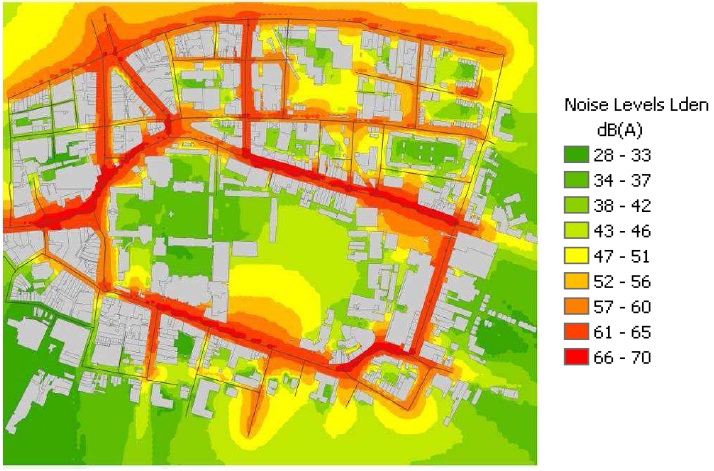Dublin Noise Maps
Noise mapping techniques employ predictive software which takes account of large amounts of information in order to estimate noise levels in a given area. The noise mapping process requires a number of detailed data sets in order to compute noise levels. The information required includes details of road surface and gradient, number of vehicles and speed of the traffic, positions of buildings and barriers and the topology of the local area. Noise maps are most commonly presented as a 2D graphical plot where colour coded contours link areas of equal noise exposure. Noise maps either show the LDEN or LNIGHT.
These are the quantities that are defined in the Environmental Noise Directive for assesing environmental noise. They are not direct predictions of the noise level at an area. These quatities try to take into account the effect of a noise source and how annoying it might be to people in the area over the long term.
The LDEN takes account of the day, evening and night time levels. The day time is from 07.00am to 07.00pm, the evening is from 07.00pm to 11.00pm and the night time is take as 11.00pm to 07.00am. The reason for considering the time that noise is produced is because noise can be more annoying at different times of the day. To compensate for this penalties are applied to noise during the evening and night time periods. This is why the LDEN cannot be compared directly to sound level measurements, it is not actually a sound level, it is an indicator of how annoying a particular noise source might be over the course of an average day.
The LNIGHT statistic is a little more straightforward. This is the long term average noise level for the night time period, 11.00pm to 07.00am. This is used as an indication of sleep disturbance caused by a noise source.
Read more about the noise maps for Dublin city
Important Note on Using Noise Maps
Noise maps are a tool intended for a specific purpose. They provide an insight into how environmental noise may be generated from a particular source such as trafic or rail transport. It is important to note that the results are not intended to be a precise calculation of the total noise exposure at any given point, and the temptation to rely too heavily on noise maps to predict the noise level at a property should be avoided.